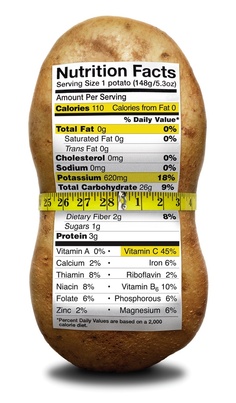How many artificial colors or flavors died to provide you with your food? Regardless of what your weight loss goals are, you should always start at the beginning. The beginning is knowing what you are putting in your body! Did you know that Spanish researchers found that women who read food labels weigh nearly nine pounds less on average than those who don’t? (as reported in Fitness magazine)
Don’t take the word of the Spanish researchers. Take it from me. I lost nearly 100 pounds by studying food labels to make sure my nutrients were on track. The first question you probably have is: what should I look for?
Below are some suggestions for those who are just starting out:
Calories
- Generally speaking, whole foods will have fewer calories than processed foods. Would you rather have two apples or a half slice of pie for the same amount of calories?
Protein
- The more protein you eat, the more full you feel. If you’re extremely active or train with weights, it also helps to maintain lean muscle mass.
Sugar
- It is true that the more sugar you eat, the more you crave. Most low-fat or processed foods have added sugar.
Beware of the following misleading claims:
Natural
- The FDA only regulates the word “natural” in meat and poultry products to include those that contain no artificial substances – although confusingly, genetically modified organisms are allowed.
- There is no official definition of what a “natural” vegetarian product can or cannot contain.
Reduced Sugar or Sugar-Free
- Typically, these foods are not low-calorie foods, and the sugar is replaced with a sugar substitute. Some sugar substitutes may cause indigestion.
Fiber
- Many food products these days have added fiber. The American Dietetic Association’s position paper on fiber states that adding purified dietary fiber to foods is less likely to benefit Americans than changing diets to include more whole foods that are rich in the substance.
Based on your own needs, you might want to review food labels for other nutrients. When I first started on my weight loss journey, I only paid attention to calories, fat, and fiber. Today, I pay attention to calories, protein, and sugar. Both approaches are getting results.
Ideally, the best foods you can eat are ones that don’t even have labels. However, as someone who has struggled with their weight for over half my life, I understand that not everyone can completely change their diet overnight. Take the first step. Read the labels, and get one step closer to a healthier you!
Note: I am not a nutritionist or dietician, nor do I play one on TV. I am someone who has slowly learned how to live a healthier lifestyle by self-informing and experimenting. To learn how you can design your own weight loss plan using the same principles I did, download my blueprint at Lose 5 Now.




5 thoughts on “Nutrition Labels 101”
Great lead-in with the cartoon!
Thanks, Traci. I’ve always been a big fan of Garfield 🙂
Very informative! Great read
Thanks for commenting, Que! It’s hard to keep track of the important parts of food labels, especially with all the recent changes in requirements.
Comments are closed.